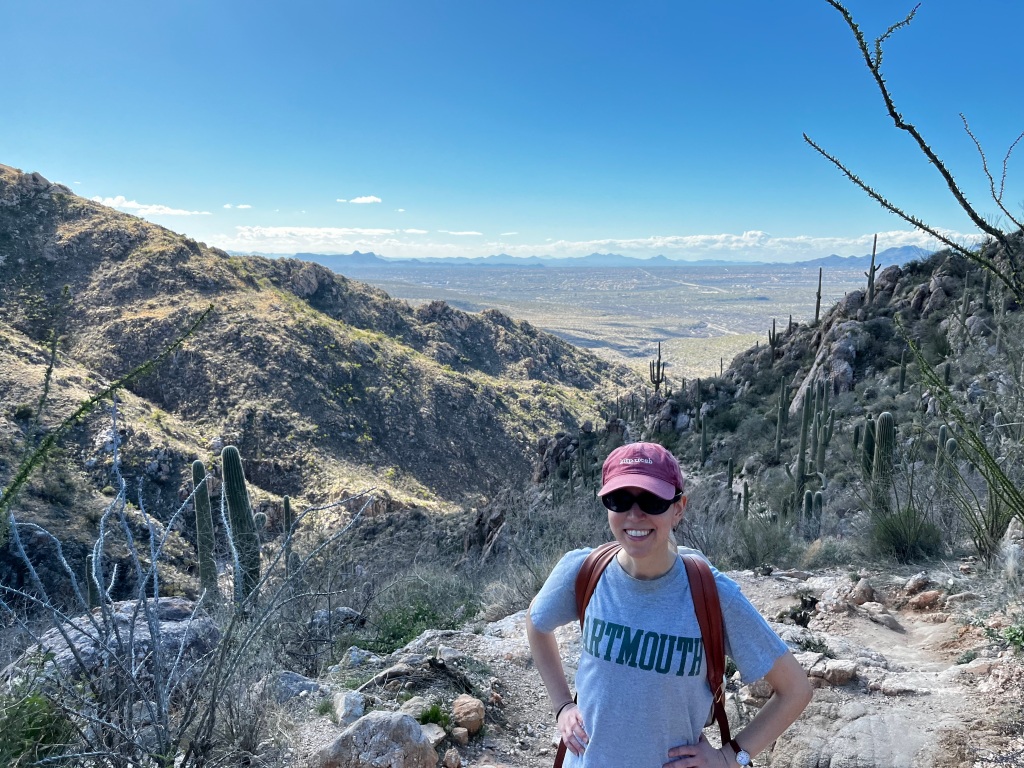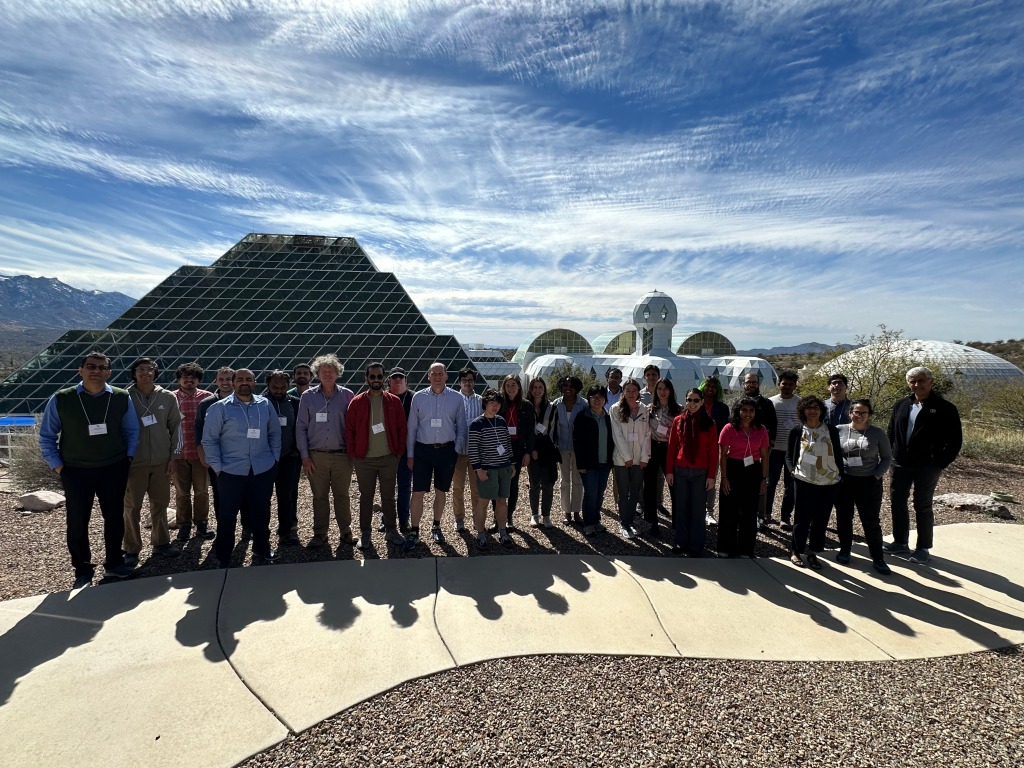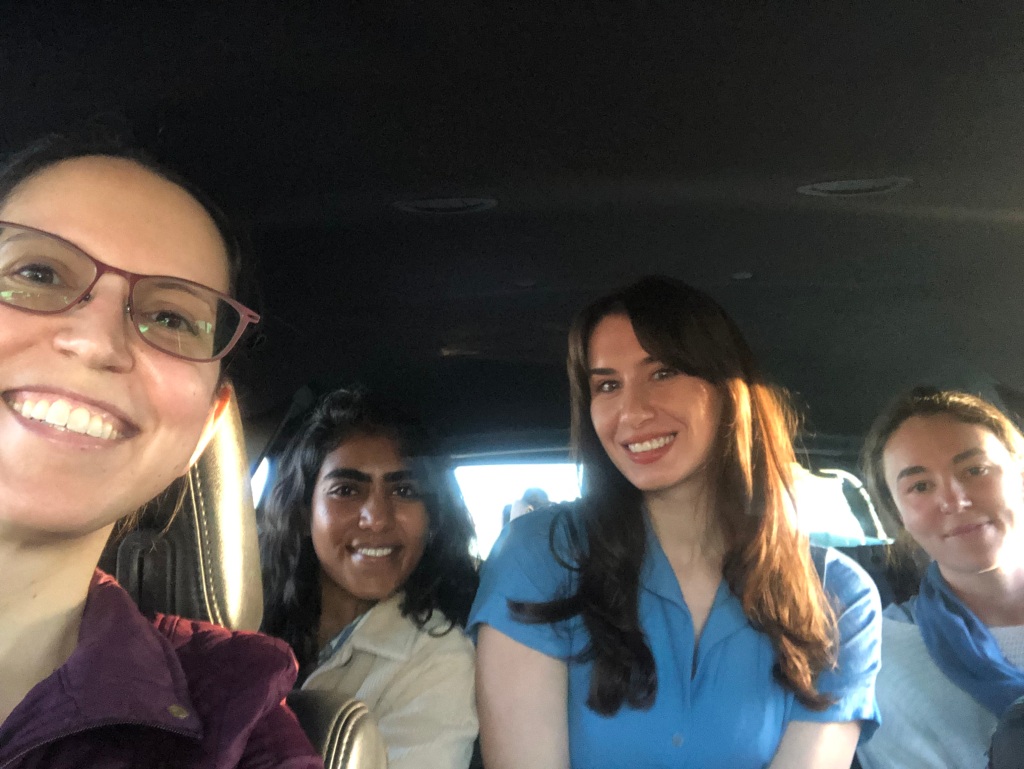Even if you don’t recognize the name, you probably recognize the saguaro cactus. It’s the archetype of the cactus, a column from which protrude arms bent at right angles like elbows. As my husband pointed out, the cactus emoji is a saguaro:  . In Tucson, Arizona, even the airport has a saguaro crop sufficient for staging a Western short film. I didn’t have a film to shoot, but the garden set the stage for another adventure: the ITAMP winter school on quantum thermodynamics.
. In Tucson, Arizona, even the airport has a saguaro crop sufficient for staging a Western short film. I didn’t have a film to shoot, but the garden set the stage for another adventure: the ITAMP winter school on quantum thermodynamics.
ITAMP is the Institute for Theoretical Atomic, Molecular, and Optical Physics (the Optical is silent). Harvard University and the Smithsonian Institute share ITAMP, where I worked as a postdoc. ITAMP hosted the first quantum-thermodynamics conference to take place on US soil, in 2017. Also, ITAMP hosts a winter school in Arizona every February. (If you lived in the Boston area, you might want to escape to the southwest then, too.) The winter school’s topic varies from year to year.&
How about a winter school on quantum thermodynamics? ITAMP’s director, Hossein Sadeghpour, asked me when I visited Cambridge, Massachusetts last spring.
Let’s do it, I said.&
Lecturers came from near and far. Kanu Sinha, of the University of Arizona, spoke about how electric charges fluctuate in the quantum vacuum. Fluctuations feature also in extensions of the second law of thermodynamics, which helps explain why time flows in only one direction. Gabriel Landi, from the University of Rochester, lectured about these fluctuation relations. ITAMP Postdoctoral Fellow Ceren Dag explained why many-particle quantum systems register time’s arrow. Ferdinand Schmidt-Kaler described the many-particle quantum systems—the trapped ions—in his lab at the University of Mainz.
Ronnie Kosloff, of Hebrew University in Jerusalem, lectured about quantum engines. Nelly Ng, an Assistant Professor at Nanyang Technological University, has featured on Quantum Frontiers at least three times. She described resource theories—information-theoretic models—for thermodynamics. Information and energy both serve as resources in thermodynamics and computation, I explained in my lectures.
The winter school took place at the conference center adjacent to Biosphere 2. Biosphere 2 is an enclosure that contains several miniature climate zones, including a coastal fog desert, a rainforest, and an ocean. You might have heard of Biosphere 2 due to two experiments staged there during the 1990s: in each experiment, a group of people was sealed in the enclosure. The experimentalists harvested their own food and weren’t supposed to receive any matter from outside. The first experiment lasted for two years. The group, though, ran out of oxygen, which a support crew pumped in. Research at Biosphere 2 contributes to our understanding of ecosystems and space colonization.
Fascinating as the landscape inside Biosphere 2 is, so is the landscape outside. The winter school included an afternoon hike, and my husband and I explored the territory around the enclosure.
Did you see any snakes? my best friend asked after I returned home.
No, I said. But we were chased by a vicious beast.&
On our first afternoon, my husband and I followed an overgrown path away from the biosphere to an almost deserted-looking cluster of buildings. We eventually encountered what looked like a warehouse from which noises were emanating. Outside hung a sign with which I resonated.
Scientists, I thought. Indeed, a researcher emerged from the warehouse and described his work to us. His group was preparing to seal off a building where they were simulating a Martian environment. He also warned us about the territory we were about to enter, especially the creature that roosted there. We were too curious to retreat, though, so we set off into a ghost town.
At least, that’s what the other winter-school participants called the area, later in the week—a ghost town. My husband and I had already surveyed the administrative offices, conference center, and other buildings used by biosphere personnel today. Personnel in the 1980s used a different set of buildings. I don’t know why one site gave way to the other. But the old buildings survive—as what passes for ancient ruins to many Americans.&
Weeds have grown up in the cracks in an old parking lot’s tarmac. A sign outside one door says, “Classroom”; below it is a sign that must not have been correct in decades: “Class in progress.” Through the glass doors of the old visitors’ center, we glimpsed cushioned benches and what appeared to be a diorama exhibit; outside, feathers and bird droppings covered the ground. I searched for a tumbleweed emoji, to illustrate the atmosphere, but found only a tumbler one:  .
.
After exploring, my husband and I rested in the shade of an empty building, drank some of the water we’d brought, and turned around. We began retracing our steps past the defunct visitors’ center. Suddenly, a monstrous Presence loomed on our right.&
I can’t tell you how large it was; I only glimpsed it before turning and firmly not running away. But the Presence loomed. And it confirmed what I’d guessed upon finding the feathers and droppings earlier: the old visitors’ center now served as the Lair of the Beast.
The Mars researcher had warned us about the aggressive male turkey who ruled the ghost town. The turkey, the researcher had said, hated men—especially men wearing blue. My husband, naturally, was wearing a blue shirt. You might be able to outrun him, the researcher added pensively.
My husband zipped up his black jacket over the blue shirt. I advised him to walk confidently and not too quickly. Hikes in bear country, as well as summers at Busch Gardens Zoo Camp, gave me the impression that we mustn’t run; the turkey would probably chase us, get riled up, and excite himself to violence. So we walked, and the monstrous turkey escorted us. For surprisingly and frighteningly many minutes.&
The turkey kept scolding us in monosyllabic squawks, which sounded increasingly close to the back of my head. I didn’t turn around to look, but he sounded inches away. I occasionally responded in the soothing voice I was taught to use on horses. But my husband and I marched increasingly quickly.
We left the old visitors’ center, curved around, and climbed most of a hill before ceasing to threaten the turkey—or before he ceased to threaten us. He squawked a final warning and fell back. My husband and I found ourselves amid the guest houses of workshops past, shaky but unmolested.& Not that the turkey wreaks much violence, according to the Mars researcher: at most, he beats his wings against people and scratches up their cars (especially blue ones). But we were relieved to return to civilization.

The ITAMP winter school reminded me of Roughing It, a Mark Twain book I finished this year. Twain chronicled the adventures he’d experienced out West during the 1860s. The Gold Rush, he wrote, attracted the top young men of all nations. The quantum-technologies gold rush has been attracting the top young people of all nations, and the winter school evidenced their eagerness. Yet the winter school also evidenced how many women have risen to the top: 10 of the 24 registrants were women, as were four of the seven lecturers.1&
We’ll see to what extent the quantum-technologies gold rush plays out like Mark Twain’s. Ours at least involves a ghost town and ferocious southwestern critters.
1For reference, when I applied to graduate programs, I was told that approximately 20% of physics PhD students nationwide were women. The percentage of women drops as one progresses up the academic chain to postdocs and then to faculty members. And primarily PhD students and postdocs registered for the winter school.






Comments